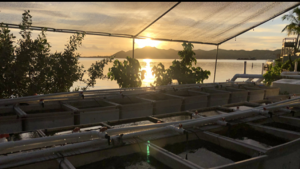
A long-term study of Hawaiian coral species provided a surprisingly optimistic view of how they might survive warmer and more acidic oceans resulting from climate change.
Study authors, including researchers from the Hawaiʻi Institute of Marine Biology (HIMB) at the University of Hawaiʻi at Mānoa, found that the three coral species studied experienced significant mortality under conditions that simulated ocean temperatures and acidity expected in the future—up to about half of some of the species died. But none of them completely died off—and some actually were thriving by the end of the study.
Results showed that 61% of corals exposed to the warming conditions survived, compared to 92% exposed to current ocean temperatures.

“It’s clear that corals are in a lot of trouble due to climate change, but our study also makes it clear that there are reasons for hope,” said Chris Jury, postdoctoral researcher at HIMB and study co-author.
The research, published in Scientific Reports, was led by a doctoral student at Ohio State University, Rowan McLachlan, who is now at Oregon State University.
While the findings are optimistic, they are also more realistic than previous studies. The study lasted 22 months—much longer than most similar research, which often spans days and up to five months. In addition, the researchers were careful to create real-life conditions. Test corals were put in outside tanks designed to mimic ocean reefs by including sand, rocks, starfish, urchins, crabs and fish. These tanks also allowed natural variability in temperature and pH levels over the course of each day and over seasons, as corals would have in the ocean.
“It’s a difficult challenge to replicate the natural system,” said Jury. “That’s why we conducted this long-term study under realistic conditions, to get as close as possible to actual coral reefs.”
Coral response to warmer, acidic conditions

Samples of the three most common coral species in Hawaiʻi, Montipora capitata, Porites compressa and Porites lobata, were placed in tanks with four different conditions: control tanks with current ocean conditions, an ocean acidification condition, an ocean warming condition and a condition that combined warming and acidification.
The two Porites species were more resilient than M. capitata in the combined warming and acidification condition. Over the course of the study, survival rates were 71% for P. compressa, 56% for P. lobata and 46% for M. capitata.
“Of the coral that survived, especially the Porites species, they were coping well, even thriving,” McLachlan said. “They were able to adapt to the above-average temperature and acidity.”
A case for hope and vigilance
The two Porites species’ findings may offer particular hope, as they are among the most common types of coral across the world and they have a key role in reef building.
While this study does lead to reasons for optimism, it does not mean that corals face no threat under climate change. Further, the study didn’t include local stressors such as pollution and overfishing that may have additional negative impacts on corals in some areas.
“Reefs are being assaulted on multiple fronts, from ocean warming and acidification, to local impacts, such as destructive fishing practices, sedimentation and coastal pollution,” said Jury. “These are serious problems, but they are also fixable problems. With sensible action, we can help to ensure that there will still be healthy coral reefs during our lifetimes, and for the generations that come after us.”
Funding for the research was provided by the National Science Foundation, UH Sea Grant College Program and HW Hoover Foundation.
This work is an example of UH Mānoa’s goal of Excellence in Research: Advancing the Research and Creative Work Enterprise (PDF) and Building a Sustainable and Resilient Campus Environment: Within the Global Sustainability and Climate Resilience Movement (PDF), two of four goals identified in the 2015–25 Strategic Plan (PDF), updated in December 2020.

